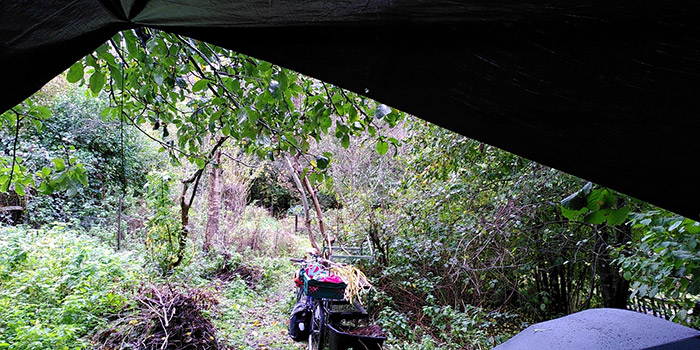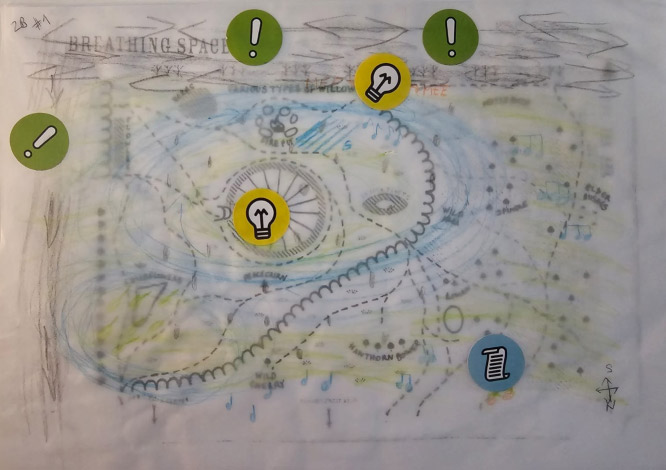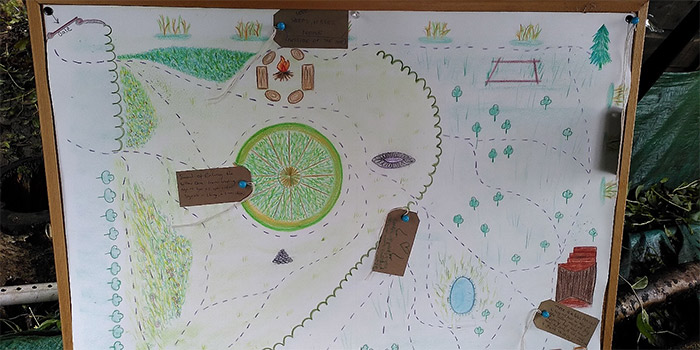Soundmapping involves bringing sound and space together. How can we explore what we are hearing through space and place? How can we explore spaces and places through sound?
With audio and mobile technologies becoming more accessible, online and digital soundmaps are increasingly common. They are often what people first think of e.g. Cities & Memory, Radio Aporee, London Sound Survey. But there are lots of ways to do this…
The Ecomusicology Project (TEP) is a great place to try out different ways of soundmapping together. This autumn we started mapping out the sounds of the plot with two free workshops – the joys of unpredictable severe weather meant we had to cancel the second workshop. But we plan to hold more through 2024 and plot out sounds as the seasons change. These workshops are being run by Brighton & Hove Music for Connection, who have also been running strings workshops and interactive listening walks on the plot as part of the TEP collective.

Bethan Prosser leads on these workshops, which builds on her PhD research and current post-doctoral project on participatory listening research. Participatory listening research is a way of listening with others to the environment to generate new knowledge and discoveries, whilst embracing different listening experiences, practices and positionalities. Bethan’s interested in how this approach can be applied to soundmapping.
For the first workshop, we were greeted with heavy rain but a tarp next to the shed created a dry cosy place to gather and one participant even brought blankets to keep us warm! Starting with a short deep listening exercise, participants spent some time exploring the plot silently before sharing what we heard in pairs. Each participant was then presented with some weatherproof tools to help capture and plot their listening around the plot. This included clipboards, an old map of the plot, tracing paper and stickers. The sticker set included different types of “sound stimulus” that Bethan has created from her research.
It was fascinating to see how everyone used these tools differently to create their unique soundmaps. For example, one participant said they think of sound in layers and colours – drawing swirls of blue and green for the wind and rain in the trees and plants. They were surprised by how much traffic was at the border (nearest to the A27). The willow dome made them think about the sounds you can still hear through the gaps -“like you’re inside but not”.

Another participant used pen to mark the main paths on tracing paper over the map, making a couple of drawings and written notes alongside the stickers. Sitting in the hawthorn bower, they were surprised by being able to hear their own facial hair as they stroked their chin. The traffic sound made them remember growing up next to a motorway and their brother-in-law saying it was just like a river and how you can think of it as any kind of white noise. They also marked the sensation of going into the willow dome, which reminded them of a film transition.


We plan to explore this outside/inside dimension more in the next workshops. There’s lots still to explore as the seasons change, the plot changes and using technology to aid our listening (e.g. hydrophone mics in the pond). If you would like to find out more and be added to an email list about listening and soundmapping workshops, please email Bethan:
bethan@musicforconnection.co.uk

Hi, this is a comment.
To get started with moderating, editing, and deleting comments, please visit the Comments screen in the dashboard.
Commenter avatars come from Gravatar.